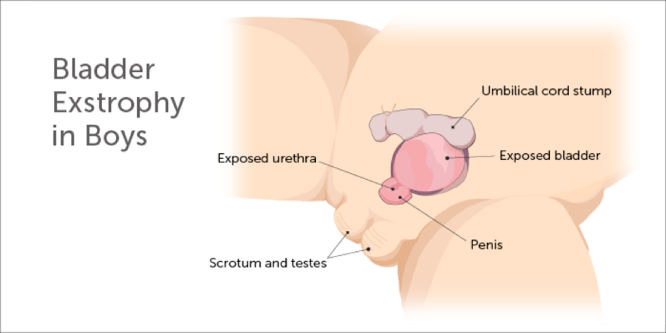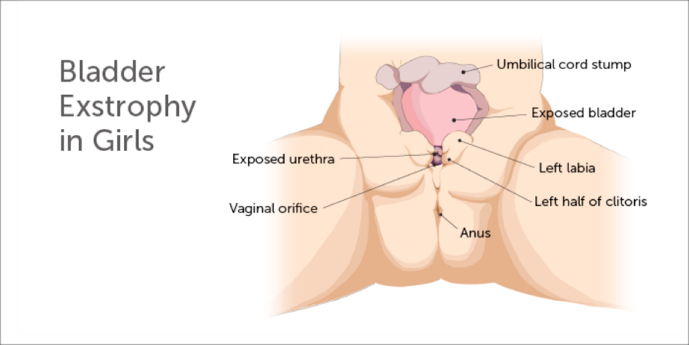Bladder Exstrophy | Symptoms & Causes
What causes bladder exstrophy?
The exact cause of bladder exstrophy is unknown. Popular theories suggest a normal structure known as the cloacal membrane might not develop normally. This may prevent appropriate tissue development, ingrowth, and the joining together of the supportive lower abdominal wall structure. Some studies show a clustering of the condition in families, suggesting that there’s an inherited factor. However, the chance for parents to have another child with exstrophy of the bladder is extremely rare and unlikely.
Bladder Exstrophy | Diagnosis & Treatments
How is bladder exstrophy diagnosed?
Bladder exstrophy may be diagnosed during a routine fetal ultrasound or other indicated imaging techniques such as magnetic resonance imaging (MRI). Often it is diagnosed immediately after birth during initial physical examination.
Prenatal care is an important aspect of health for every expectant mother and fetus. The prenatal diagnosis of bladder exstrophy allows time for learning about the condition and preparing for the anticipated care.
How is bladder exstrophy treated?
Treatment for bladder exstrophy begins at birth. Your care team should be readily available to help you in the immediate post-natal period, but it is important to note that there are typically no emergency medical needs right after birth. The primary goal when caring for a child with bladder exstrophy is to:
- Develop adequate bladder function and promote urinary continence
- Preserve normal kidney function
- Provide acceptable appearance and function of the external genitalia
- Ensure that your child has a typical and normal childhood
Bladder exstrophy repair
At Boston Children’s, two experienced surgeons work together for each major surgery related to exstrophy-epispadias complex. Surgical reconstruction is typically performed eight to 12 weeks after birth, at which time the bladder is closed, the bladder neck (area of transition from bladder to urethra) is reconstructed, and the epispadias is repaired (entire urethra is closed into a tube) at the same time. Incisions in the pelvic bones (osteotomies) are performed at the time of surgery to help provide more normal anatomy of the bones and muscles of the pelvis. The ureters, which connect the kidneys to the bladder, may be reimplanted to help prevent vesicoureteral reflux (VUR). Children may require additional surgery during later years to manage urinary incontinence and urinary tract infection.
This surgical approach of closing the bladder, reconstructing the bladder neck, and repairing the epispadias at one time is referred to as complete primary repair of bladder exstrophy (CPRE). The day prior to CPRE, your baby undergoes osteotomies by an orthopedic surgeon, and an epidural catheter is placed to help with pain related to the operation. The osteotomies allow for a safe reconstruction the following day by taking the tension off the bladder and abdominal wall. By separating the osteotomies and surgical reconstruction of the bladder, we have been able to avoid intensive care unit admissions following our surgical reconstruction. After the osteotomies, your baby is fit for a spica cast, which remains in place approximately eight weeks after CPRE to optimize safety and healing. Our average length of stay in the hospital is approximately seven to 10 days after the surgery.
We feel that delaying surgery beyond the first few weeks of life may have several advantages for the child. This timing presents an opportunity for normal bonding between the baby and parents before the initial reconstructive surgery and lengthy recovery period that follows. The time between birth and initial repair allows for growth, development, and additional maturation of some organs and systems prior to the complex surgery and makes the anesthesia and surgery safer.
Other centers may prefer a staged approach to bladder exstrophy care, where the bladder closure, bladder neck reconstruction, and epispadias repair are divided into separate time points. At Boston Children’s Bladder Exstrophy Program, we have experience in repairing bladder exstrophy in stages. There is a possibility that your child’s anatomy may make a staged reconstruction the preferred surgical approach.
What is the long-term outlook for bladder exstrophy?
After initial treatment for bladder exstrophy, your child will require lifelong follow-up. Care is ongoing and can involve a range of testing to evaluate your child’s growth and development, urinary continence, kidney function, and sexual and reproductive health. In many instances, behavioral modification, medications, and physical therapy are incorporated as part of the post-surgical treatment plan. In some cases, additional surgery is required during childhood, adolescence, and young adulthood.
Boston Children’s is committed to providing the care that your child needs. Every child is different and as your child grows, their bladder and kidneys grow with them. Our team in the Bladder Exstrophy Program will work with you to develop the best plan of care specific to your child’s needs.
How we care for bladder exstrophy
The experts in our Bladder Exstrophy Program provide exceptional pediatric care. Our team includes physician specialists in urology, nephrology, orthopedic surgery, anesthesiology, radiology, and nuclear medicine, as well as nurses, social workers, and child life specialists who will care and support you and your child at every step, from diagnosis through treatment, and even after your child returns home. We are always here to answer any questions and to listen to your concerns.
We offer a variety of resources for families, including access to the Fetal Care and Surgery Center (FCSC). The FCSC provides support through prenatal counseling, treatment, and follow-up for families with a confirmed or suspected fetal congenital anomaly. In addition, medical staff, social workers, child life specialists, and spiritual care services are available to support expectant parents.




